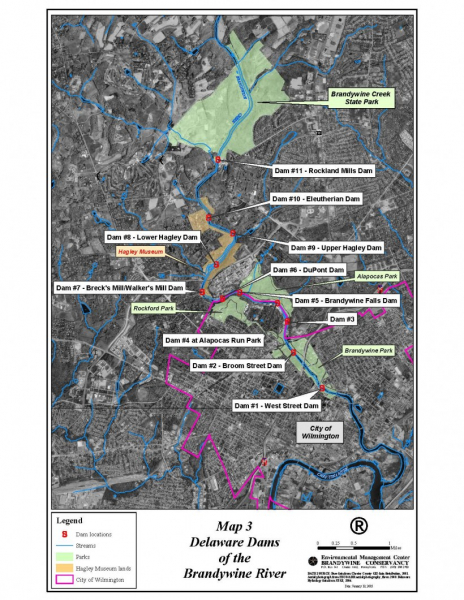This week, we’re taking a look at the different types of urban industrial pollution, how NOAA responds to pollution events and aids in the recovery of natural resources lost due to pollution, and what you can do to help keep pollution out of your waterway. Stay tuned as we explore these topics through a series of blogs. In this guest blog from the Brandywine Conservancy by guest author Gerald McAdams Kauffman, director of the University of Delaware Water Resources Center, learn more about the restoration efforts that led to the return of the nation's founding fish to our most historic watershed. (This blog was originally published by the Brandywine Conservancy on June 6, 2020).

In 2005, the Brandywine Conservancy conducted a river reconnaissance and explored the feasibility of restoring the American shad to the Brandywine by removing 11 dams that impeded their ancestral spawning runs since the colonial days of the Swedes in Delaware. In 2012, the Conservancy was able to remove two dams that reopened 18 miles of the East Branch of the Brandywine above West Chester, Pennsylvania to fish passage, but there was still much more work ahead.

American Shad or Alosa Sapidissima (Latin for “savory fish”) is an anadromous species that lives in the ocean for much of its adult life and returns after four to five years to spawn in the freshwater rivers of their birth. The nation’s founding fish swam up the Delaware and the Schuylkill in the spring of 1778 at just the right time in American history to feed George Washington’s starving troops at Valley Forge. The American shad was so numerous in the Delaware Valley that the Brandywine was known as “Fishkill” by the Dutch, who noted the glistening fish stacked from bank to bank. Over the years, stocks of this “poor man’s tarpon” were decimated due to overfishing, industrial pollution and colonial dams that impeded their ancestral spawning runs. But with management of fish stocks and improved water quality from the 1970s Clean Water Act, a group known as “Brandywine Shad 2020” has made it their mission to bring back the species to the river to swim in places they haven’t been seen in three centuries.
Brandywine Shad 2020 was founded in 2017 by riverside residents Hunter Lott and Jim Shanahan of Wilmington, Delaware, along with a coalition of partners consisting of the City of Wilmington; Delaware DNREC; the Brandywine Conservancy; Hagley Museum and Library; Brandywine Red Clay Alliance; The Conservation Fund; The Nature Conservancy; and the University of Delaware Water Resources Center. Using science from the Brandywine Conservancy’s 2005 recon study, the City of Wilmington removed the century-old West Street Dam No. 1 and remnants of a circa 1740s dam on the Brandywine River in the fall of 2019. The efforts so far have already been a success, with shad being caught in downtown Wilmington (the shad capital of Delaware) earlier this spring right underneath the main artery of the East Coast megalopolis—the I-95 bridge.
With the momentum now regained, Brandywine Shad 2020 has secured a grant from the National Fish and Wildlife Foundation under the Delaware River Basin Conservation Act to restore fish passage to the remaining 10 dams in Delaware. This will eventually allow the shad to swim up to Pennsylvania and reopen 24 miles of the river to spawning past the Brandywine River Museum of Art in Chadds Ford, as well as the forks of the Brandywine in West Chester, Pennsylvania. The goal is for the shad to swim through the First State up to the Keystone State for the first time since the three lower counties of Delaware were part of the Pennsylvania colony. When this occurs, the two states will indeed once again be joined by a common river.

With the ongoing successful efforts of the shad project, the Brandywine River renaissance is finally falling into place.
The remaining Delaware Dams 2 through 11 are numbered moving upstream from downtown Wilmington up past the Hagley Museum to Rockland. The plan is to remove deteriorating Dams 3, 4, 6 and 11 in 2020 and install bypass fishways at structurally intact Dams 2 and 5 in 2021. Work on Hagley Dams 7 through 10 is slated for 2022. Fish passage at lower Dams 2 through 6 will allow the shad to spawn from sea level five miles inland to 70 feet above sea level in the Piedmont (Italian for foot of the mountains) to the circa 1802 Hagley dams by 2021.
The Brandywine Shad 2020 effort is not just about the fish, it’s also about the history, culture and environmental recovery of the beautiful and bounteous Brandywine. For millennia long before the Europeans set foot in the New World, the indigenous people—the Lenni Lenape—knew the Brandywine as the river of the long fish (the Atlantic sturgeon). When early European settlers arrived in what is now Delaware, they built dams across the Brandywine River and the White Clay Creek to power mills for their locally grown barley, wheat, corn and other grains. While the creation of these dams played an important role in the economy and industry for the state, they also set off a decades-long dispute between the European colonists and the area’s indigenous people. The shad were a critical food source depended on by the Lenape and—over time—the dams impeded the upstream passage of the fish to their spawning grounds.

Now with the shad restoration effort fully underway, dam removals spurred by Brandywine Shad 2020 will allow the fish to once again spawn in the Brandywine River and will restore a lost part of the region’s natural diversity and unique heritage. And not only will the shads’ progeny be born in the Brandywine, but they in turn will return to the river of their birth for first time in centuries.


